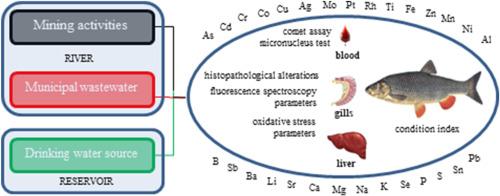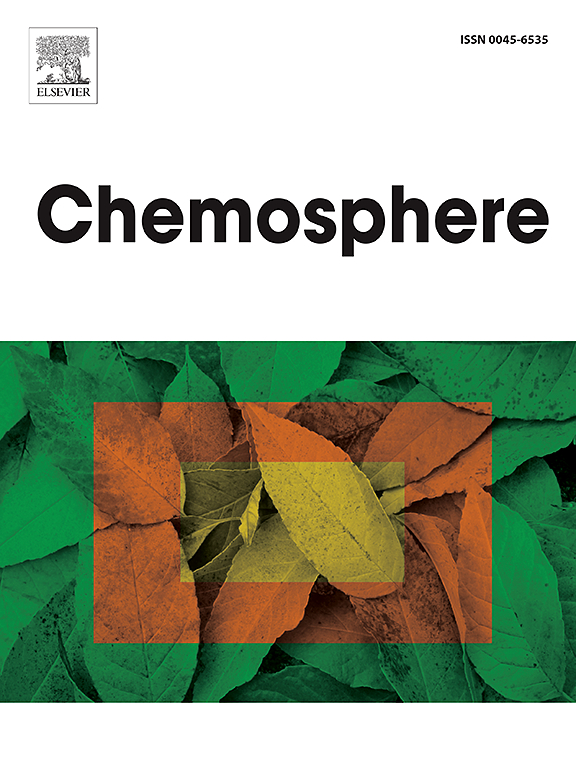采矿活动和城市废水对欧洲鲢(Squalius cephalus)元素积累和综合生物标志物反应的影响。
IF 8.1
2区 环境科学与生态学
Q1 ENVIRONMENTAL SCIENCES
引用次数: 0
摘要
本研究旨在利用电感耦合等离子体光发射光谱法(ICP-OES)测定佩克河(长期暴露于采矿活动)欧洲鲢鱼鳃和肝脏中 29 种元素的浓度以及鳃、肝脏和血液中的生物标志物反应,并将这些结果与伊巴尔河(受经处理的城市废水排放的影响)和克鲁什奇察水库(饮用水源)的个体进行比较。此外,还计算了金属污染指数 (MPI)。用于检测调查地点城市污水存在情况的辅助分析包括粪便污染的微生物指标(总大肠菌群和大肠埃希氏菌)分析。我们使用条件指数、彗星试验、微核试验、氧化应激参数、组织病理学改变和荧光光谱参数评估了从分子到生物水平的生物标志物反应。综合生物标志物反应 v2(IBRv2)对多生物标志物分析进行了总结。在这些地点中,克鲁什奇察的两类指示细菌值最低,而佩克河的两类指示细菌值最高。由于斑岩铜矿的开采,佩克河的鱼鳃和肝脏中的铜浓度都比其他地方高出数倍,生物标记反应和 IBRv2 值证实了这一点。相反,克鲁什奇察水库的鱼类受元素污染的影响最小,这也从较低的 MPI 和 IBRv2 值中得到证实。伊巴尔河位于佩克河和克鲁斯奇察水库之间,其生物标志物的反应与元素在肝脏和鳃中的积累相对应。在本研究分析的所有生物标志物中,状态指数的灵敏度最低。这项研究的结果表明,荧光光谱法可能是快速筛查污染负荷导致的鳃结构变化的一种方法。本文章由计算机程序翻译,如有差异,请以英文原文为准。

Effects of mining activities and municipal wastewaters on element accumulation and integrated biomarker responses of the European chub (Squalius cephalus)
This study aimed to determine concentrations of 29 elements in the gills and liver as well as biomarker response in gills, liver, and blood of European chub from Pek River (exposed to long-term mining activities), and to compare these findings with individuals from Ibar River (influenced by emission of treated municipal wastewater) and Kruščica reservoir (source of drinking water) using inductively-coupled plasma optical emission spectrometry (ICP-OES). The metal pollution index (MPI) was also calculated. Supporting analyses for the detection of the municipal wastewater presence at investigated localities included analyses of microbiological indicators (total coliforms and Escherichia coli) of faecal pollution. We have assessed biomarker responses from molecular to organism level using the condition index, comet assay, micronucleus test, oxidative stress parameters, histopathological alterations, and fluorescence spectroscopy parameters. Multibiomarker analysis was summarized by Integrated Biomarker Response v2 (IBRv2). Among these locations, Kruščica exhibited the lowest, whereas the Pek River displayed the highest values for both categories of indicator bacteria. Due to the porphyry copper ores mining, individuals from Pek River had several times higher Cu concentrations in both gills and liver compared to the other localities which was confirmed by biomarker responses and IBRv2 value. On the contrary, fish from Kruščica reservoir were the least affected by elemental pollution which is also confirmed by low MPI and IBRv2 values. Responses of biomarkers correspond to the elemental accumulation in the liver and gills of the Ibar River are positioned between the Pek River and Kruščica reservoir. Of all the biomarkers analyzed in this study, the condition index was the least sensitive. The results of this study showed that fluorescence spectroscopy may be a method for fast screening of structural changes in gills caused by the pollution burden.
求助全文
通过发布文献求助,成功后即可免费获取论文全文。
去求助
来源期刊

Chemosphere
环境科学-环境科学
CiteScore
15.80
自引率
8.00%
发文量
4975
审稿时长
3.4 months
期刊介绍:
Chemosphere, being an international multidisciplinary journal, is dedicated to publishing original communications and review articles on chemicals in the environment. The scope covers a wide range of topics, including the identification, quantification, behavior, fate, toxicology, treatment, and remediation of chemicals in the bio-, hydro-, litho-, and atmosphere, ensuring the broad dissemination of research in this field.
 求助内容:
求助内容: 应助结果提醒方式:
应助结果提醒方式:


